by Winding Pathways | Aug 29, 2019 | Birds, Bugs, Flowers/Grasses, Garden/Yard, Nature
On a sunny, warm, late summer day we watched countless bees and butterflies foraging on prairie plants, hummingbirds sipping nectar from Cardinal flowers, and small birds pausing to drink water on the cup plants. That evening, bats swooped across the sky as clouds gathered. Then, came the downpour.
So, we wondered, where do birds and bees and bats go during storms or just to rest? A bit of Internet searching yielded some fascinating information.
Bees
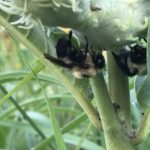
seeking shelter from the rain
Bees are active in the day and need sleep just like humans do. How they sleep is quite different. Bees and many insects do not have eyelids. They relax the body and antennae and sometimes fall over. Sometimes, the other bees in a honeybee colony prop up the “sleeping” bee. As we see in this video, and similar to human babies, they sleep in shorter bursts. This sleep helps their memory. Remember, bees, especially honeybees explore new foraging spots, return to the hive, communicate through a “dance” telling other bees where the source of nectar is. As with people, good sleep helps them perform better. Look for bees on the underside of leaves and grass blades after a rain or in the early morning.
Butterflies
Butterflies also seek shelter on the underside of leaves or grass blades. This vegetation protects them from furious winds and debilitating raindrops. Think about it! How delicate a butterfly’s wings are and how a large raindrop can punish it. A Scientific American article gave a great comparison to us humans – being whacked by a water balloon twice the mass of a bowling ball!
Birds and Bats
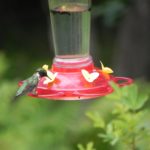
One hummingbird fell into a torpor on the feeder!
To rest, Hummingbirds go into torpor – a sleep-like state where the body temperature drops to conserve energy. They sometimes hang upside down as we see in this video. When the temperatures rise, they “wake up”. They can fly in moderate rains.
Some larger birds, like turkeys, actually come out in rainstorms and forage on insects that are slowed down by the cooler temperatures. At night, turkeys roost in trees. Watching them navigate through dense forests into the tops of sturdy trees is amazing.
Nighthawks, along with their nocturnal companions bats, find daytime shelter on tree branches. Bats tuck under tree bark flaps, in crevices and caves, and enter tiny cracks in homes making attics a cozy den.
Next time you are out and about, look carefully on undersides of leaves and grass blades, study branches of trees for unusual shapes that might be a roosting bird, and notice animals out and about at different times of the day and in different weather.
by Winding Pathways | Jul 4, 2019 | Garden/Yard, Garden/Yard, Mammals, Nature
People are surrounded by synanthropes. It’s a long and obscure word that is descriptive of hundreds of wild plants and animals.
A synanthropic species is one that benefits from and lives close to people. Essentially, if people disappeared these plants and animals would struggle to survive and, perhaps, disappear themselves. They need us! Other species are semi-synanthropic and live close to people or benefit from human action but might live in lower numbers in wild places.
At Winding Pathways, we strive to restore species native to our area of Iowa. We’ve had success, but we’re still surrounded by synanthropes that require our presence. Fortunately, we don’t have Norway rats or rock pigeons but these and other species are common in the biggest cities worldwide. They are wildly successful in the grittiest urban areas.
House mouse and Norway rat
House fly
House Sparrow, American Robin, House Finch, House Wren, Rock Pigeon, Canada Goose, and Ringneck Pheasant
Raccoon, Opossum, Woodchuck
Plants:
Dandelion, Purslane, Lambs quarters, Kentucky bluegrass, And many common weeds.
We encourage everyone to look around and notice plants and animals in their homes and yards and learn whether they’d be there without human presence. Expand our list! If they would disappear should the yard be a virgin wilderness and people were absent, then they are synanthropes.
-
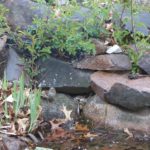
-
English Sparrows thrive around people.
-
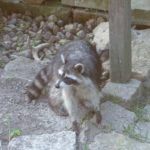
-
Raccoons forage mostly at night.
-
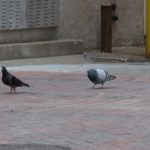
-
Pigeons depend on people to thrive.
by Winding Pathways | Jun 6, 2019 | (Sub)Urban Homesteading, Flowers/Grasses, Garden/Yard, Garden/Yard
Weeds Brighten Our Lawn
Too many people worry about lawn weeds and spend money to buy and spray toxic chemicals. We take a different view. What many call weeds are actually beneficial and we find fascinating. The often-uninvited plants that diversify our lawn connect us with human history, teach us botany, sometimes provide nutrition, and add color to our yard.
We don’t spray or fertilize our lawns at Winding Pathways. The mower gets exercise when grass gets shaggy, but we’re never bothered when new plants show up. Instead, we try to identify them and sometimes mow around them to let them bloom and add color to Winding Pathways.
Here are three “weeds” that we are enjoying this summer for their color:
Hawkweed
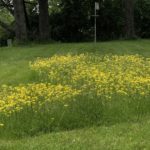
Hawkweed is “asexual”.
In mid-spring, a small patch of tiny hawkweed plants was poking through our grass. Rich mowed around them and by late May we enjoyed watching bright yellow hawkweed blooms dance in the sunny breeze.
There are many species of hawkweed. Most are exotic but some are native. Most sport yellow flowers although some can be reddish. Farmers sometimes consider them a weed. Perhaps the most interesting thing about them is their unusual reproduction. They usually spread by seed, but hawkweed seeds aren’t fertilized, meaning that the seed is an exact genetic clone of its parent. They’re asexual!
We’ll enjoy our Hawkweed until their blooms fade and then likely will mow the patch.
Star of Bethlehem
One of our favorite early spring wildflowers is the impressive but delicate bloom of the native Bloodroot. Its pure white petals are showy against the late March or early April ground. A common early summer lawn weed that has a bloodroot-looking flower is the Star of Bethlehem. It’s a lily that is sometimes sold in nurseries. The plant is not native and shows up in our lawn, probably the result of a previous owner planting bulbs years ago. Star of Bethlehem can be invasive, so we enjoy its showy bloom but mow it off before it has a chance to seed. The plant is a perennial and comes up from bulbs each year, so mowing won’t eliminate it but may keep it from seeding.
-
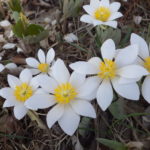
-
Bloodroot is an early spring bloomer. Photo credit Susan Hrobar
-
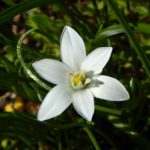
-
Star of Bethlehem.Six-petaled flower. Pixabay photo
Shepherd’s Purse
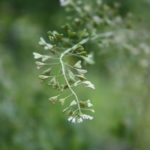
Shepherd’s Purse. From Pixabay
An intriguing plant that grows more on the side of the lawn than in the middle is Shepherd’s Purse. Its name comes from the triangular flat fruits that look like a tiny purse. Native to Europe and Asia Minor it may now be the second most common weed worldwide. Shepherd’s Purse has medicinal and food value and may have been deliberately spread by people.
Nature loves diversity. A function of invasive plants is their very nature. Spray a lawn and kill every plant species other than Kentucky Bluegrass and soon “weeds” will move right in. Diversity creates a certain degree of ecological stability, but there’s always change. A fascination of tending a natural unpoisoned lawn is learning to identify new species as they arrive by themselves and watching plant transitions over the years. A common uninvited plant one year may totally disappear the next to be replaced by some new species. Observing is just plain fun that can never be enjoyed by the person who poisons fascinating lawn plants.
by Winding Pathways | May 30, 2019 | (Sub)Urban Homesteading, Flowers/Grasses, Garden/Yard, Garden/Yard, Nature, Trees/Shrubs
Enjoying a Welcoming Yard
On the evening of May 17th, one of nature’s brightest colors greeted us at Winding Pathways. It was a brilliant male scarlet tanager, a somewhat rare bird that we only see briefly each May.
The next morning, he was joined by a female, and we assume they’ll nest in Faulkes Heritage Woods that adjoins our property. Tanagers are birds of the big woods, and they’ll find comfortable lodging in the big oaks nearby.
We bought Winding Pathways ten years ago partly because it adjoins the 110-acre Woods protected from development by a conservation easement. It’s mostly steep land that drops down to Indian Creek about a quarter of a mile from our home.
Creating a Welcoming Yard
Since we bought our land, we’ve diversified the yard by restoring prairies and increasing the variety of savanna and woodland wildflowers in shady areas, used prescribed fire to reduce exotics, and installed many birdhouses and feeders. Thanks to the nearby woods and our more open prairie yard with the savanna in between, we enjoy a rich array of bird species. Some, like woodpeckers and chickadees, stay around all year but more migrate to nest here or stop by on their trek to nest further north. We keep a running list of the birds we see from our dining room table each spring. Some we just see winging over but many stop to eat and rest.
-
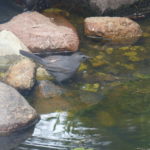
-
Catbird by water
-
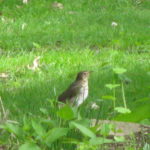
-
The Swainson’s Thrush moves through in the spring.
-
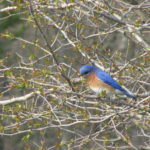
-
Bluebird in tree
Growing Bird List
We’re adding to this list daily but here’s what we’ve spotted and heard so far in May 2019:
Great Blue Heron, Barred and Horned Owl, Canada Goose, Black Capped Chickadee, Tufted Titmouse, Cardinal, White and Red Breasted Nuthatch, Downy, Hairy, Red Bellied, Red Headed, and Pileated Woodpeckers and Flicker, Turkey Vulture, House Sparrow, Wild Turkey, Red Breasted Grosbeak, Northern Oriole, Wood Duck, Common Yellowthroat, Indigo Bunting, Yellow Warbler, Louisiana Waterthrush, Blackpoll Warbler, Yellow Rumped Warbler, Scarlet Tanager, Eastern Kingbird, Phoebe, Great Crested Flycatcher, Cooper’s Hawk, Bald Eagle, Cowbird, House Sparrow, Starling, House and Carolina Wren, House Finch, Red Tail Hawk, Cooper’s Hawk, Crow, Pelican.
-
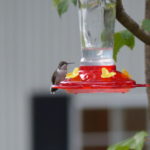
-
A hummer at the feeder.
-
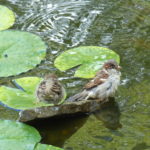
-
A water source helps attract birds.
-
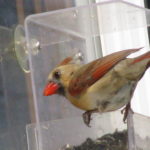
-
Female Cardinal at window feeder.
And the list keeps growing. You, too, can create a welcoming yard. This introductory YouTube video from Canada gives a quick overview of the important elements in attracting birds to a yard. It’s totally “Homegrown” and short. You can create welcoming space on a condominium patio, at a retirement or nursing home, an urban lot or spacious acreage.
Another YouTube video explains how to bring natural elements together to create natural areas. In this case, a “forest.” Again, from large scale to small we can all do this! We would, naturally, adapt to our region of the country and world. The concepts are similar.
What to Consider When Creating a Welcoming Yard
How much time/money do you want to invest?
Do you want to create a naturalistic landscape with native plants?
Do you want to harvest food from the space?
Are your neighbors tolerant of change?
What local codes affect what you want to do? (Ordinances or Covenants)
How prevalent are deer in the neighborhood?
How long do you plan to live in the home?
-
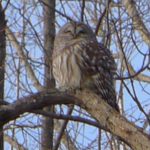
-
Waiting
-
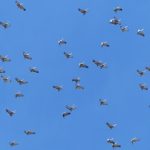
-
Wheeling overhead
-
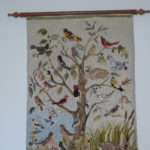
-
A hooked rug by Yvonne Fellows
We’re lucky to have Indian Creek and Faulkes Heritage Woods near Winding Pathways, but even yards not adjacent to natural areas can increase bird variety by creating diverse habitat. Spring is the best season to plant prairies and shrubs! Learn more about birds, their habits and habitats at the Cornell Laboratory of Ornithology.
-
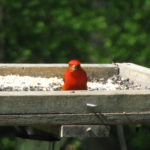
-
Extra nutrition at the feeder.
-
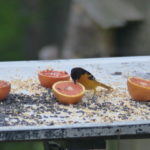
-
A male northern oriole
-
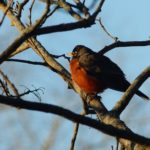
-
A robin surveys the area
by Marion Patterson | Apr 25, 2019 | (Sub)Urban Homesteading, Children/Play, Garden/Yard, Garden/Yard, Nature
-
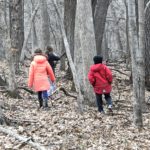
-
Kids take to the woods.
-
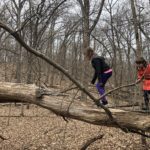
-
Starting off carefully.
-
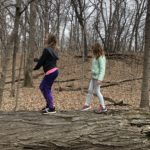
-
Walking confidently.
Kid Adventure
Nature reduces stress. We saw it in action at Winding Pathways on an early April Sunday morning.
About 15 kids from the Faith Formation Group of Peoples Church Unitarian Universalist visited. Most were five to ten years old. After collecting eggs and scattering treats for the hens, we took them to Faulke’s Heritage Woods. It’s a 110-acre woodland protected from development by a conservation easement held by the Iowa Natural Heritage Foundation.
It wasn’t a guided walk. It was a kid adventure. As we distantly watched, the kids scampered into the oaks where they discovered a huge fallen tree spanning a ravine. A natural bridge. They couldn’t resist making the crossing and then raced from fallen log to fallen log, traversing each. Laughter entertained the many standing trees as the kids were enveloped in nature, inventing games and having fun. No constructed playground in a city park or schoolyard matches the wonder and fun of ponds, prairies, and tiny streams.
-
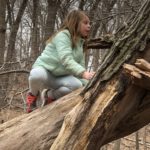
-
Careful calculations
-
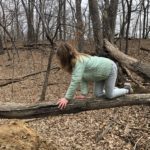
-
Learning to navigate a log.
-

-
Exploring the log
Lots of research has been conducted on nature’s ability to relieve stress in both adults and children. Experts call time spent in beautiful places the nature pill and even 20 minutes spent walking in the woods reduces stress.
Everyone Benefits
Mary Carol Hunter recently completed a nature pill study and said, “Our study shows that for the greatest payoff, in terms of efficiently lowering levels of the stress hormone cortisol, you should spend 20 to 30 minutes sitting or walking in a place that provides you with a sense of nature.”
We’re lucky to have Faulke’s Woods adjacent to Winding Pathways, but most of our time outdoors is spent close to our home on our own property. Often, it’s simply sitting in the yard enjoying a cup of coffee as we watch chickadees flit around.
Hunter’s words, “sense of nature” are powerful. Although visits to national and state parks, wildlife refuges, and nature preserves are wonderful stress relievers, anyone’s yard or balcony can do the same. We created Winding Pathways several years ago to encourage people to enjoy their yard, even if that’s a tiny apartment balcony in a big city. Structuring the yard or balcony to create natural beauty attracts interesting wildlife while giving people easy and free access to the “nature pill.”
Go outside and have fun, just like the kids did in Faulke’s Woods.
by Winding Pathways | Nov 29, 2018 | Garden/Yard, Mammals, Pests
After a balmy fall, the television weather report promised near record cold and snow in three or four days. Mice don’t have televisions but somehow, they knew this because several of the tiny mammals successfully entered our house just before cold arrived. One scurried across the floor as we were reading the morning newspaper.
Years ago we read our then young children a delightful book about a mouse in the house. The story goes: “There is a mouse in the house. It is a very nice mouse. It has a long, long tail and shiny eyes. My mother likes the mouse. But, she says, ‘A mouse does not belong in a house.’”
We agree and have developed a strategy to keep them out – at least most of them.
One tactic we do not do is poison. Karla Bloem of the International Owl Center in Houston, MN, reminds us that poison spreads. When a predator eats a poisoned mouse, it absorbs the poison. Over time, the poison builds up and kills the predator. People end up with more mice that can cause problems.
Here’s what we do at Winding Pathways:
- Encourage predators. We love to hear the barred owls call on dark evenings, and occasionally we spot a red-tailed hawk in a tree out the window. Both are outstanding mouse catchers. Owls work the night shift and hawks the day.
- Keep food secure. If mice smell dinner they’ll come right in uninvited and help themselves. It’s important to never leave food out unprotected. We store grain, flour, pasta, cookies and other foods in metal or stout plastic containers with tight-fitting lids. We don’t leave fruits and vegetables on countertops.
- Tighten up the house. Before it gets cold, we check our house over carefully. Any narrow cracks get filled with caulk. If we find a wider crack, we fill it with expanding foam. Often entry points for mice and insects are around pipes and wires leading into the home. Caulk and expanding foam help seal off the entry. Drain pipes sometimes are entry points. “Chore Girl” type metal cleaning pads work great for filling pipes where liquids or air needs to come and go. Wad up the metal pads and jam them into the pipe. Spaces in the cleaning pads let air and moisture enter or leave but keep mice out.
- Bring out the traps. Despite our best efforts, some mice make it into the house. Usually, we don’t see them but do see their calling cards – their tiny black droppings.
Effectively setting traps
Old fashioned mouse traps still catch mice efficiently, but a few tricks make success more likely. (With the exception of the poison information in this website, we have found this information to be appropriate.)
Bait. Probably the best bait is peanut butter. It just takes a tiny dab on the trigger to work.
Placement. Where you set traps is important. Mice naturally run along walls and dart under counters if they can. Traps set in the middle of a room are less likely to catch mice than those set along a wall with the trigger on the wall side.
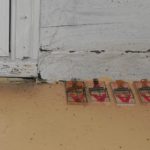
Place several mouse traps where mice tend to enter.
Double up. It’s usually most effective to set several traps in the same spot. So, set two or three touching each other. The first trap or two might not catch the mouse. Usually one will
Keep setting the traps until you catch no more mice. Often people assume they have one mouse, but likely, there are more. Keep trapping until they’re all gone. We dispose of dead mice by simply tossing them outside for our local opossum to eat. They can be flushed down the toilet. Always be sure to wash your hands after handling mice or traps.




























